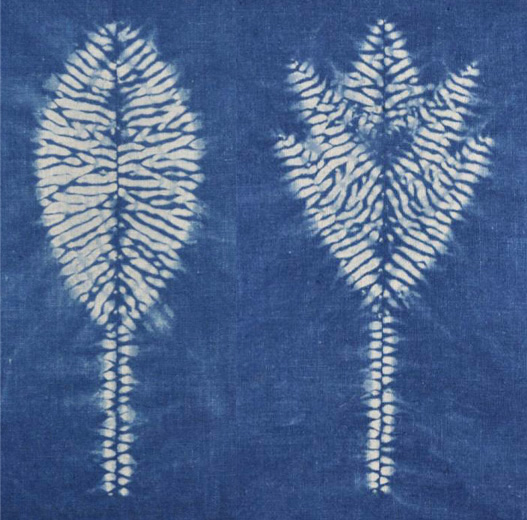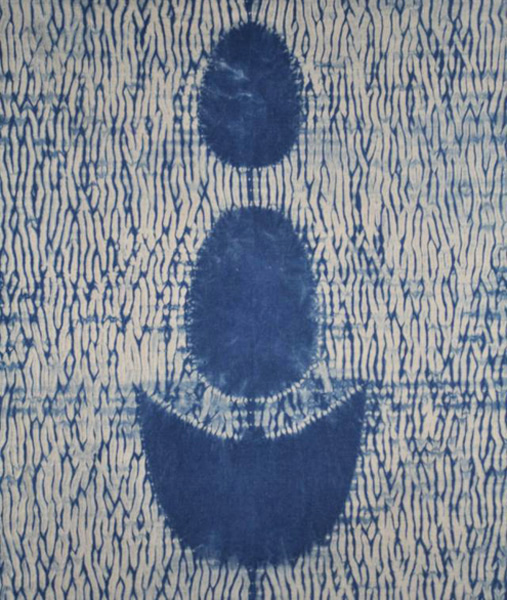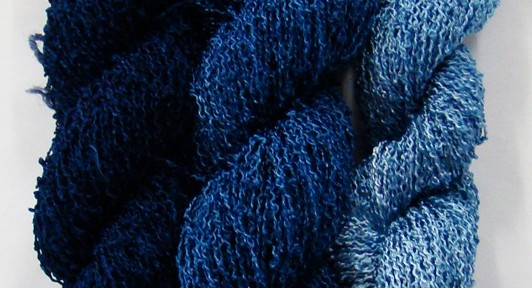Confluence Conference Workshop: Vicki Jensen & The Magic of Indigo
January 11, 2011
 From the Studio of Vicki Jensen (text and images by Vicki Jensen)
From the Studio of Vicki Jensen (text and images by Vicki Jensen)
We all love the beautiful blue color found in indigo-dyed textiles. The time-honored process of dyeing with indigo is the perfect companion to shibori techniques. Whether I am working with white linen or a piece of fabric previously dyed with MX dyes, I find the process of adding color and pattern to fabric from the indigo vat a magical experience.
 My personal favorite shibori technique is one that entails stitching the cloth to shape it before dyeing. I am drawn to stitched shibori because it is a rhythmic, meditative process that is very relaxing for me. Stitch-resist fabrics do rely on a certain degree of faith, since so many hours are invested in the process of stitching one piece of cloth. But the end results–created from the marks made by each stitch–are stunning.
My personal favorite shibori technique is one that entails stitching the cloth to shape it before dyeing. I am drawn to stitched shibori because it is a rhythmic, meditative process that is very relaxing for me. Stitch-resist fabrics do rely on a certain degree of faith, since so many hours are invested in the process of stitching one piece of cloth. But the end results–created from the marks made by each stitch–are stunning.
Image 1 (Mokume at top of page) and 2 (right) are examples of stitched shibori on linen, which is my favorite fabric to stitch on. Stitched shibori also provides  a way for me to create patterns from nature, from which I find most of the inspiration for my art work.
a way for me to create patterns from nature, from which I find most of the inspiration for my art work.
The next three images are examples of how I took a low-water immersion dyed fabric and created a new layer of color and pattern on each of them through other shibori processes. The Bomaki shibori in Image 3 creates beautiful, delicate lines on the cloth. I also used found objects, like jar covers and smooth pebbles, to create the Itajime shibori in Image 4 and the bound resist shibori in Image 5.
Image 4 and the bound resist shibori in Image 5.
Last of all, I enjoy working with yarns. Image 6 is an example of a value gradation done on some rayon skeins of yarn. Knitting these in a gradation from light to dark in a scarf will make a beautiful piece of wearable art to add to my accessories.
In my Confluence pre-conference 5-day workshop, The Magic of Indigo, I will introduce all of the techniques shown here and many more. You will have your own indigo vat, made from 60% pre-reduced indigo, to work with for the 5 day workshop. This new form of indigo is so easy to use. You don’t need lye to make the indigo vat anymore; soda ash is used instead. Plan on going home with a beautiful stash of indigo-dyed fabrics!
The Magic of Indigo, I will introduce all of the techniques shown here and many more. You will have your own indigo vat, made from 60% pre-reduced indigo, to work with for the 5 day workshop. This new form of indigo is so easy to use. You don’t need lye to make the indigo vat anymore; soda ash is used instead. Plan on going home with a beautiful stash of indigo-dyed fabrics!
Confluence Conference registration begins on Monday, January 17, 2011.
To register, go to conference.surfacedesign.org
You will need your SDA membership number and password to begin registration. If you need to retrieve this information, send an e-mail request to updates@surfacedesign.org
_____________________________
Vicki Jensen is the Classroom Coordinator and Lab Manager for PRO Chemical & Dye. She earned her MFA in Fibers from Arizona State University and completed a residency at Arrowmont School of Arts and Crafts in 1996. She has taught workshops at weaving, spinning, and quilting guilds around the US. Her resist-dyed textiles, art quilts and felted work have been selected for many juried and invitational exhibitions and private collections in both the US and Japan. Vicki is also the Massachusetts/Rhode Island SDA Area Representative. Visit her website at www.vickijensen.net



1 Comment
Barbara Killian says
March 4, 2015 at 11:48 am
Do you have retail sales for your indigo yarn? Love it!
Related Blog Articles
Confluence Conference
Friday Fibers Roundup: Embroidered Flora
Confluence Conference
Friday Fibers Roundup: Embroidery Evolution
No Thumbnail Available
Confluence Conference
Friday Fibers Roundup: Woven Color